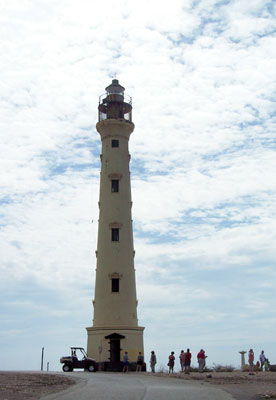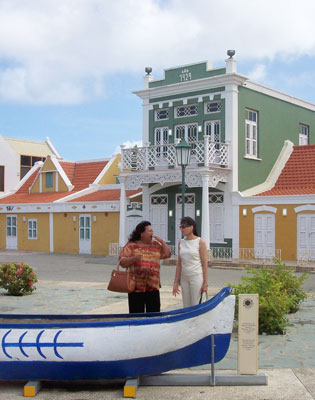¡Arriba, Aruba!
This item appears on page 63 of the October 2013 issue.
(Second of two parts)
When my wife, Gail, and I visited the Southern Caribbean island of Aruba in June 2013, we found multiple choices for exploring the island via land-based tours.
At our island home base, the Divi Village Golf & Beach Resort (where we received an industry discount), there was a convenient tour desk for De Palm Tours (phone, in the US and Canada, 800/609-7374), the island’s largest operator of land and sea tours.
On a recommendation from our Divi contact, we opted for De Palm’s 5-hour “Discover Aruba” coach tour at $63 per person. This proved to be a good choice. We toured in air-conditioned comfort while experiencing many of the island’s main attractions. (The alternative was a bouncy, 4-wheel-drive, exposed-to-sun-and-wind adventure that covered much the same itinerary and was more costly.)
Around Aruba
Our first tour stop was the landmark California Lighthouse, completed in 1916 and named for the steamship California, which wrecked nearby in 1891. It’s located on the northwest tip of Aruba, overlooking the exclusive housing enclave of Arashi Beach.
We next visited little Alto Vista Chapel, also known as Pilgrims Church, located on a bluff above Aruba’s rugged north shore. The present chapel, completed in 1952, stands in the same location as the original chapel built by Venezuelan missionary Domingo Silvestre in 1750.
Included on our tour was a welcome excursion to the calm waters of popular Baby Beach, where we had ample time for swimming and snorkeling. We also traveled through San Nicolas, Aruba’s second-largest city (pop. 18,000) and a developing cultural hub that features a weekly Thursday night street fair.
During our island jaunt, I appreciated that our route took us through many neighborhoods away from the tourist beach areas. We were able to get a good feel for how the locals go about their daily lives.
Two if by sea
Desirous of a quality snorkeling experience, Gail and I opted for De Palm Tours’ 4-hour morning snorkeling cruise aboard their large, comfortable catamaran. The snorkeling was close to shore and, while it was not exceptional, we did see a lot of colorful fish and had a chance to leisurely drift over a small sunken German ship from the WWII era.
The cost of $78 per person included all snorkeling equipment and a healthy lunch on board plus all drinks. Go easy on their tasty rum concoction if you’re planning to snorkel.
The excursion provided expansive views of Aruba’s shoreline, particularly the Palm Beach area. Aruba proudly boasts nine separate dive sites.
It’s about the water
With little reliable rainfall, Aruba’s water needs are provided for by a high-quality desalinization system, resulting in expensive water costs for local residents and little greenery away from resorts and the few golf courses.
The positive, for all, is the purest-tasting drinking water imaginable directly from the tap. This translates into zero expenditure for bottled water.
Free tours of Aruba’s desalination plant, the world’s second largest, are available on Thursday mornings at 9:30 a.m. Call 297 585 4805 to reserve a tour.
When to travel
Unlike most Caribbean destinations, Aruba attracts large numbers of visitors throughout the year.
The trade winds are a constant, with June and July being the two windiest months. However, the off-season airfares and accommodation costs from June through September are definitely much more value oriented than those of peak season, December through March.
Like many tourism-oriented islands today, Aruba is very advanced in the timeshare arena, with many of Aruba’s hotels and resorts offering such options, the source of a sizeable portion of the island’s repeat visitors.
The legions of timeshare visitors to Aruba are typically on a 7-day, Saturday-to-Saturday booking. If you are not relegated to such time limitations, I strongly recommend traveling to and from Aruba at any time other than weekends. You’ll avoid very long lines for check-in, security and Customs at the Aruba airport, as we thankfully were able to do.
A travel bonus for visitors returning from Aruba to the US is that, by special agreement, US Customs has a full operation at the Aruba airport. This makes it possible to clear US Customs before departing from the island. When you arrive back in the US, it is as though you have been on a domestic flight, which makes continuing travel arrangements much easier.
The Aruba repeat dynamic
So why does Aruba have the highest percentage of repeat visitors of any Caribbean destination?
The island’s economy is essentially 100% dependent on tourism, so Aruba is simply off the charts in being “tourist user friendly.”
You can use American dollars virtually everywhere. And if you rent a vehicle, you’ll find that driving is on the right-hand side of the road.
The combination of a very safe island environment, a broad spectrum of abundant, convenient tourism amenities and the islanders’ genuine, infectious friendliness is a winning trifecta that’s hard for other Caribbean destinations to beat.
The capper is Aruba’s enviable southern Caribbean location — well outside the hurricane belt yet only a 2½-hour flight from Miami.
Before you go
Keep in mind that with many US air carriers servicing Aruba, frequent-flyer-mile seats can be easier to come by than with other Caribbean destinations. But do plan well ahead to secure frequent-flyer-mile seats, especially if you want to travel during the peak winter season.
For a variety of Aruba accommodation options, contact Divi Resorts (800/367-3484).
For general information on travel to Aruba, contact the Aruba Tourism Authority (800/862-7822).
Keck's Beyond the Garden Wall
Recipe for Aruban cocktail — a veiled long pour of Hispania,
liberal splashes of Southwest Africana,
genial lacings of Netherlandia,
a trace sprig of Amerindian
Mix by hand with trade wind assist to harmonious blending
— Randy’s acknowledgment of the unique Aruban genealogy


